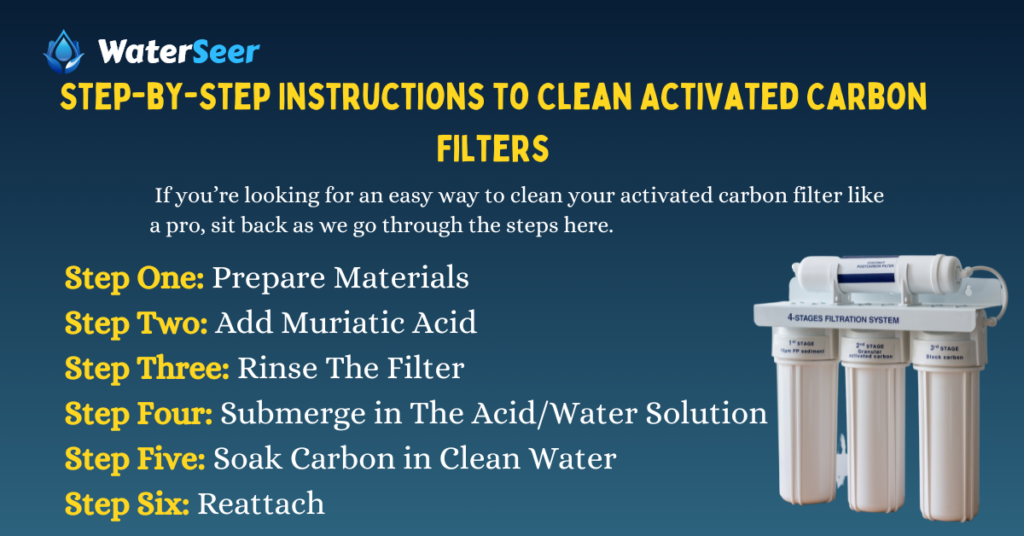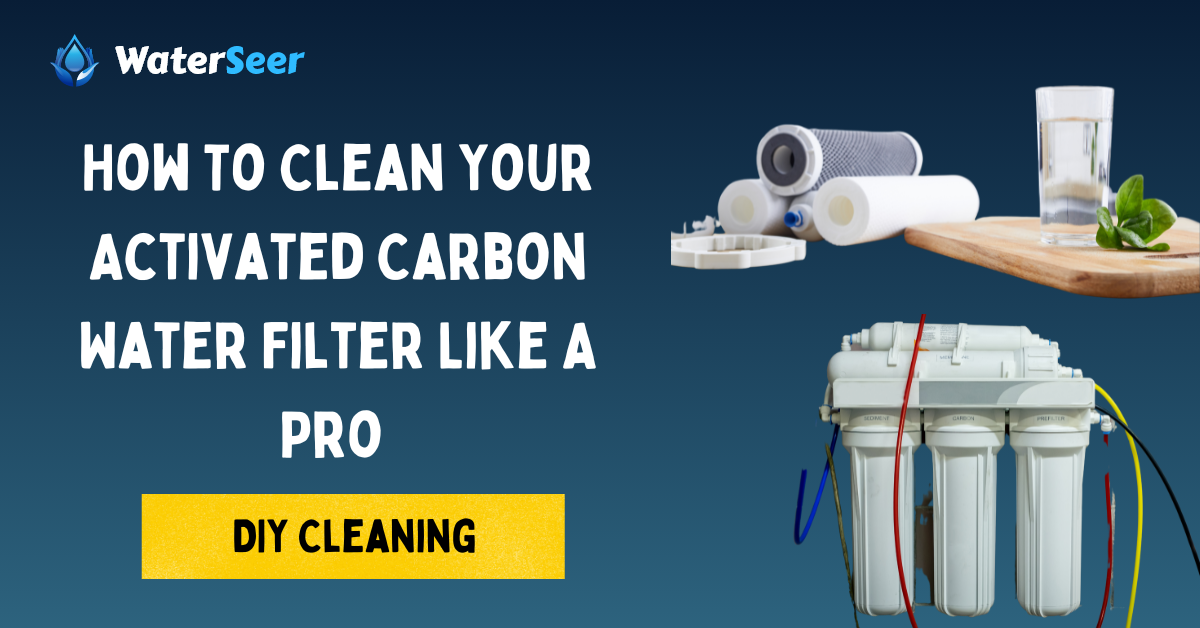Chlorine and chloramines are used to treat water in water treatment facilities before they get to the home. While this seems like a noble cause, vast deposits of chloramines remain in the water, affecting its taste and smell, and can also cause cancer. Activated carbon filters are one of the most effective ways to remove the bad taste and odor from water and ensure clean water in your home.
An activated carbon filter traps the impurities on the carbon surface, which means it will require regular cleaning to continue getting clean water. Regular cleaning prevents the chemicals and pollutants from blocking the pores and significantly reducing water flow.
While it is crucial to clean your activated carbon, doing it the right way is even more essential. So how do you clean an activated carbon water filter? We’ll find out in this guide, but first, let’s see the types of activated carbon filters.
Types of Activated Carbon Filters
Activated carbon filters use heat or a booster to prolong water contact with the carbon filter, making the filter more effective. There are primarily two types of activated carbon filters, and they are:
1. Powdered Activated Cabon Filter (PAC)
Here, the carbon is ground into minute particles to increase its surface area and make more contact with the contaminated water. Activating the carbon in the filter prolongs its exposure to the water, giving it more time to purify it. PAC is produced from organic matter like wood and anthracite with high levels of carbon.
Reducing the carbon block to fine particles less than a millimeter in size ensures more carbon is exposed to the water. Activated carbon filters can have the carbon in powdered form, even though this is less popular than the GAC model, especially in water purification.
2. Granular Activated Carbon Filter (GAC)
Granular activated carbon, otherwise called GAC, is the most popular type of activated carbon for water purification and features granulated carbon materials. GAC is formed by heating organic materials without air before being crushed into granules.
GAC is the ideal type of activated carbon for highly contaminated water, as it is also suitable for use in extensive treatment facilities and homes. It has a smaller surface area than PAC, which means less contact with water. Most activated carbon filtration mechanisms used at home will come with GAC systems as they can remove most of the pollutants in the water, causing the smell, bad taste, and some chemicals like mercury.
Step-by-Step Instructions to Clean Activated Carbon Filters

Activated carbon filters effectively remove foul odor and taste from water, mainly when caused by chlorine and chloramine materials. However, their effectiveness is only as long as they stay clean and unclogged. Considering ACF’s mode of operation is sticking to the dirt, they’ll get clogged up quickly. If you’re looking for an easy way to clean your activated carbon filter like a pro, sit back as we go through the steps here.
Step One: Prepare Materials
This step goes without saying, as it prepares you for the cleaning process. Preparing all you need includes filling a bucket with room-temperature water and clearing the area around the filtration unit to give unhindered access.
Step Two: Add Muriatic Acid
Muriatic acid has the natural ability to break down substances and different materials. Its value is essential in breaking down the chemicals and heavy metals stuck to the activated carbon. This acid is easy to get as you can buy it from nearby home improvement stores.
Add two cups of muriatic acid to the bucket of water and stir using a plastic stirrer. It may require a minute or two of mixing for the acid to dissolve in the water completely.
Step Three: Rinse The Filter
There are usually substantial contaminant deposits on the activated carbon, so reducing these deposits is vital. Rinsing the carbon with running water will reduce the apparent deposits, while the muriatic acid focuses on removing the leftover pollutants, which are usually more challenging.
Place the activated carbon under running water from a faucet or hose and lightly scrub using a soft brush. This will remove most of the debris attached to the filter and get it ready to be submerged.
Step Four: Submerge in The Acid/Water Solution
Some smaller materials will still be stuck to the carbon even after removing the debris with a soft brush and running water. The hydrochloride acid and water solution will strip the contaminants off the carbon; however, it takes some time to do this.
To rid the carbon of the dirt, submerge the carbon inside the bucket with the acid/water solution, and leave for about five days. The setup should be kept at room temperature, away from direct sunlight and extreme temperatures. The acid solution will strip the contaminants off the carbon and leave it almost ready for reuse.
Step Five: Soak Carbon in Clean Water
Hydrochloric acid will typically remain on the carbon after the cleaning process, contaminating your water. After stripping dirt from the carbon, the carbon will have an acid solution, contaminating your clean water. Soaking the carbon in clean water for about ten minutes will remove the acid.
Repeat the process by flushing and soaking in another clean water for five minutes for a thorough wiping. Use a garden hose or faucet to rinse the carbon to remove any remaining impurities.
Step Six: Reattach
With the activated carbon clean and ready for reuse, put the filter back into the filtration system by following the same process when removing. The refitting method may vary based on the filter, but it is usually straightforward. See the manufacturer’s guide for details.
FAQ’s
Cleaning an activated carbon filter is a straightforward process but may come with some questions, so we have this section answering popular questions about the process.
Can You Reuse Activated Carbon Filters?
You can reuse an activated carbon filter by cleaning and declogging the carbon. Ensuring proper maintenance will make it possible to reuse this filter; however, reusing it is only possible where there is no severe clogging with dirt.
How Many Times Can You Clean an Activated Carbon Filter?
Ideally, clean this filter only once before placing it, as doing this more frequently will leave the filter less effective.
How long Before You Replace The Activated Carbon Filter?
Six months is ideal for replacing the carbon filter under normal usage. Otherwise, you should pay attention to the amount of dirt the filter has picked and replace the filter when the pores have been seriously blocked.
Is it Worth Cleaning an Activated Carbon Filter?
Yes, it is worth cleaning and reusing, especially if you have an expensive setup. Extensive activated carbon filtration systems that can last years are usually more costly to replace. For more affordable filters, you may be better off replacing them rather than trying to clean them.
Considering these filters are often cheap and easy to get, you may wonder if it is worth going through the stress of cleaning and reusing.
Conclusion
Cleaning an activated carbon filter is easy; however, it takes several days to complete, so you must first consider if it is worth cleaning or replacing. A muriatic acid solution is the primary cleaning agent used to rid the carbon of debris.
If you have the time, cleaning this filter will save you a few bucks or more, depending on your filtration type. If you want to install a new filtration system, this list of the best-activated carbon filters is helpful.

